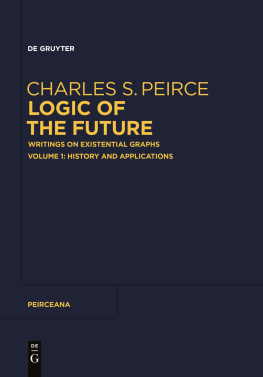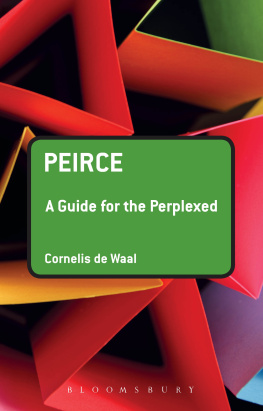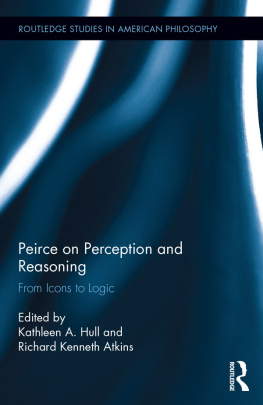Contents
Guide

Charles S. Peirce
Logic of the Future Volume 1
Peirceana

Edited by
Francesco Bellucci and Ahti-Veikko Pietarinen
Volume 1

ISBN 978-3-11-064934-5
e-ISBN (PDF) 978-3-11-065140-9
e-ISBN (EPUB) 978-3-11-064962-8
ISSN 2698-7155
Bibliographic information published by the Deutsche Nationalbibliothek
The Deutsche Nationalbibliothek lists this publication in the Deutsche Nationalbibliografie;
detailed bibliographic data are available on the Internet at http://dnb.dnb.de.
2020 Walter de Gruyter GmbH, Berlin/Boston
www.degruyter.com
Acknowledgments
The work on the three volumes of Logic of the Future has taken fifteen years to complete. This means a considerable number of people and sources of support have accumulated over the years that are to be acknowledged and deeply thanked for their respective contributions.
An edition on Peirces graphical logic was conceived during the class I gave at the University of Helsinki on Peirces Logic and Philosophy in autumn 2004. At that time, it became obvious tome that Peirces logic can never be adequately studied, let alone deeply researched, understood and put into an informed perspective within the history of ideas, when there is a nearly total absence of sources to expose it in full details.
It was the students of that class of 2004 that ignited the work on the present volumes. Its 20-odd students, including Jukka Nikulainen, Henrik Rydenfelt, Lauri Snellman, Lauri Jrvilehto, Michael von Boguslawski, Harry Alanen, Peter Schulman and many others, provided initial assistance in manuscript inspection and transcription as part of the course assessment. Useless skills, current university management would say; fond of standardised syllabi, rubrics, grading drills and quick flow-through rates, a work that aims at slow editions of old texts is not seen as the worlds first priority.
There is one person without whom this edition would not have been possible to be produced at all. My long-term research assistant, Jukka Nikulainen, who has served as a technical editor of these three volumes and has provided the first-ever  package (EGpeirce) by which one can now typeset any graph, special mark or symbol that ever emanated from Peirces hand, with ease and uniformity. Jukka also encoded a large majority of the hundreds of complex graphs that appear in these three volumes, improving the package along the way and adding new features to it. We believe that by now everything that Peirce ever designed and wanted to design as a special graph, type, character, mark or signa plethora of his typographical eccentricities notwithstandinghave been incorporated into the functionality of the Peirce
package (EGpeirce) by which one can now typeset any graph, special mark or symbol that ever emanated from Peirces hand, with ease and uniformity. Jukka also encoded a large majority of the hundreds of complex graphs that appear in these three volumes, improving the package along the way and adding new features to it. We believe that by now everything that Peirce ever designed and wanted to design as a special graph, type, character, mark or signa plethora of his typographical eccentricities notwithstandinghave been incorporated into the functionality of the Peirce  package. And much more is available in it than is in fact needed for the purposes of compiling the present editions. Peirces ethics of notation dictates that pieces of notation are just as important as the prose overall, and that whenever new notation is introduced, reasons for it are not to be taken lightly. Design and typesetting practices have to follow suit, and indeed Jukka has considerably assisted the production of the CRCs of these volumes for the press, honing the notations and checking many of the transcriptions as I slowly progressed with them. He has also searched and compiled information on many of Peirces references as well as prepared both the index of names and the index of words. Nikulainen, above all, deserves to be acknowledged as having done an amount of work vastly exceeding anything that is to be expected of a technical editorprobably years rather than months since 2004in order to bring the edition into its present shape.
package. And much more is available in it than is in fact needed for the purposes of compiling the present editions. Peirces ethics of notation dictates that pieces of notation are just as important as the prose overall, and that whenever new notation is introduced, reasons for it are not to be taken lightly. Design and typesetting practices have to follow suit, and indeed Jukka has considerably assisted the production of the CRCs of these volumes for the press, honing the notations and checking many of the transcriptions as I slowly progressed with them. He has also searched and compiled information on many of Peirces references as well as prepared both the index of names and the index of words. Nikulainen, above all, deserves to be acknowledged as having done an amount of work vastly exceeding anything that is to be expected of a technical editorprobably years rather than months since 2004in order to bring the edition into its present shape.
Claudia Cristalli also went out of her way in helping to bring the edition into its near- completion.Without hermany suggestions and concrete advice on organisation and presentation of the material, the progress on these volumes might have slouched altogether. In particular, she gave valuable proposals on organising the editorial, introductory and survey parts.
Francesco Bellucci deserves an equally immeasurable gratitude for pressing on with finalising these volumes. Not only did he check many of the items and transcriptions but also closely researched their content, coming up with important perspectives concerning their interpretation. The three volumes and their editorial introductions have benefitted enormously from our scholarly collaboration over the last five years.
Marc Champagne and Liu Xinwen have followed the progress of this project over the years. Both have provided a number of comments and corrections on the introductory parts, and deserve a special thanks for having performed such laborious deeds.
An equally special thanks for the readers drudgery also go to Gary Furhman, Jeffrey Brian Downard and Jon Schmidt, who have checked and proof-read the material in Parts I, II and III, respectively. A number of mistakes has been eliminated thanks to the careful reading of the selections. A number of others that inevitably remain will be of the sole responsibility of the editor.
These editions would probably have not seen the light of day had it not been for the enthusiasm and intellectual support of Nathan Houser, with whom I regularly conversed on the prospects of such a work ever since my stay at the Peirce Edition Project in the autumn of 2005 as a post-doctoral Fulbright grantee. It is thanks to Nathans vocal accentuation on the importance of bringing about a thematic edition on graphs, and above all the unprecedented scholarship that he represents in the Peirce community, that have kept me going with the work. Andr De Tienne, Director of the Peirce Edition Project, has been equally supportive of the enterprise from the get-go. Conversations with him have supplied vital links and clues by which one could go about navigating the amazing mazes that the literary output of this American mind puts before us.
Over the years, John Sowa, Matthew Moore and Helmut Pape have all provided experienced advice, John on the topical relevance of Peirces graphical logic, and Matt and Helmut on the challenges of editing Peirces papers for a thematic collection. Susan Haack has followed the project with interest, and I do not doubt that any new material that might be found in these texts would only support the conclusions she has already arrived at.
My first graduate class on Peirce was given by Risto Hilpinen, who taught logic and philosophy of science at the University of Turku in early 1990s and who was the first to notice that Peirce had arrived at surprisingly similar semantic and logical ideas as others did much later, in particular the game-theoretical semantics independently discovered by Jaakko Hintikka in the 1960s. I am honoured to have an opportunity of including an Introductory Note from Prof. Hilpinen to the first volume of this edition.
Discussions with the late Jaakko Hintikka in 20002015 on Peirces logic have enabled me to put many of the related contributions into a sharper perspective. Peircemiles ahead of Frege in logic and in the philosophy of mathematics, he once told me. The similarities between Hintikkas and Peirces philosophies are indeed quite striking (Pietarinen 2018), but can be explained by the similarities in the methods of logic and the significance placed on having good logical notations, the relational apparatus of thought, the value placed on proofs, and the semantic (ormodel-theoretic, semeiotic, notational) outlook on ones philosophical investigations. Both Peirce and Hintikka had put scientific and human inquiry ahead of bare epistemology: both advocated an action-first epistemology. That there is reality and truth in such philosophy is reflected in the comment I once received from Jaakko on my presentation that explored connections between the two thinkers. I had suggested that the sheer number of them makes one almost believe in reincarnation, to which he replied: Yes, but who incarnated whom?









 package (EGpeirce) by which one can now typeset any graph, special mark or symbol that ever emanated from Peirces hand, with ease and uniformity. Jukka also encoded a large majority of the hundreds of complex graphs that appear in these three volumes, improving the package along the way and adding new features to it. We believe that by now everything that Peirce ever designed and wanted to design as a special graph, type, character, mark or signa plethora of his typographical eccentricities notwithstandinghave been incorporated into the functionality of the Peirce
package (EGpeirce) by which one can now typeset any graph, special mark or symbol that ever emanated from Peirces hand, with ease and uniformity. Jukka also encoded a large majority of the hundreds of complex graphs that appear in these three volumes, improving the package along the way and adding new features to it. We believe that by now everything that Peirce ever designed and wanted to design as a special graph, type, character, mark or signa plethora of his typographical eccentricities notwithstandinghave been incorporated into the functionality of the Peirce  package. And much more is available in it than is in fact needed for the purposes of compiling the present editions. Peirces ethics of notation dictates that pieces of notation are just as important as the prose overall, and that whenever new notation is introduced, reasons for it are not to be taken lightly. Design and typesetting practices have to follow suit, and indeed Jukka has considerably assisted the production of the CRCs of these volumes for the press, honing the notations and checking many of the transcriptions as I slowly progressed with them. He has also searched and compiled information on many of Peirces references as well as prepared both the index of names and the index of words. Nikulainen, above all, deserves to be acknowledged as having done an amount of work vastly exceeding anything that is to be expected of a technical editorprobably years rather than months since 2004in order to bring the edition into its present shape.
package. And much more is available in it than is in fact needed for the purposes of compiling the present editions. Peirces ethics of notation dictates that pieces of notation are just as important as the prose overall, and that whenever new notation is introduced, reasons for it are not to be taken lightly. Design and typesetting practices have to follow suit, and indeed Jukka has considerably assisted the production of the CRCs of these volumes for the press, honing the notations and checking many of the transcriptions as I slowly progressed with them. He has also searched and compiled information on many of Peirces references as well as prepared both the index of names and the index of words. Nikulainen, above all, deserves to be acknowledged as having done an amount of work vastly exceeding anything that is to be expected of a technical editorprobably years rather than months since 2004in order to bring the edition into its present shape.